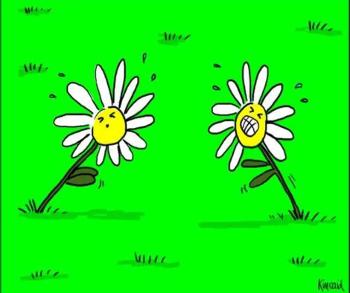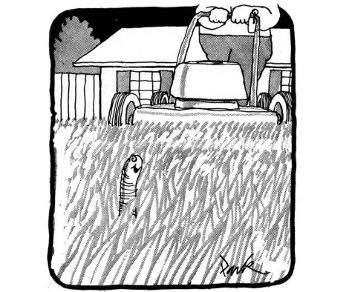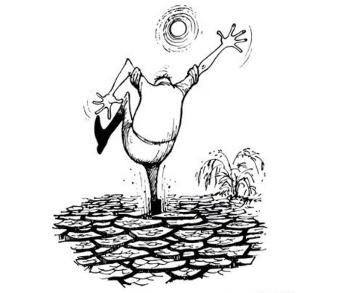Lawn disease?
A lawn is an area of short, beautiful, mown grass in a yard or a garden. It is so natural that a well-tended property is an encouraging thing to any gardener, but compared to any planting, it can experience many challenges. For example, grasshoppers or chewing insects may attack the glass blades. Also, burrowing critters, like gophers, may interfere with the grassroots and cause green tops to die. It is not difficult to point out lawn patches that are dying. Knowing what is causing the problem and how to eradicate it is often challenging. Please have a look at some of the lawn problems and their cure.
DANDELIONS:
This is a widely spread weed of the daisy family. It can grow anywhere. Though, it does best in sunny and moist areas. One thing with dandelion is that it has a well-immersed root structure. Left unattended for years, it can suffocate nearby grasses and plants. In addition to that, its seeds sprout anywhere they fall.
Control:
Dandelions do have a two-year life cycle to mature. So when they sprout the first year, get a weeding- folk and dig them out from the root. If you miss some and they flower, do not hesitate to dig them out again before they reach the seed stage. Suppose they are already in the seed stage and spreading their progeny. You must start digging everything out of the garden and planting the grass again.
DEW WORMS:
They are also known as night crawlers. This is because they are most active at night though they appear and crawl about during the wet and rainy seasons. The disadvantages of dew worms are that they excrete on the lawn during rainy or after watering the lawn and make the yard uncomfortable to walk upon and mow. The pass also leaves the lawn surface bumpy and uneven.
Control:
• Ensuring your lawn has a high amount of organic matter.
• Apply the law of sand. This is because it irritates the body of the dew worm; you can apply thin layers of it to the entire lawn.
• Make sure to maintain even and deep soil moisture.
• Using lower pH may discourage the dew worms. To achieve that, you can use Turf Revolution pH Degreaser on your lawn using a fertilizer spreader.
• Lawns should be well aerated.
CHINCH BUGS:
These are lawn pests that smell awful when you crush them. Most of the time, they make yellow or brown patches on your lawn in dry conditions.
Control:
• Water well your lawn for three to four weeks to help keep them under control. This is because Chinch bugs love hot, dry weather.
• It is correct to say that lawns need some thatch to insulate the soil from very high temperatures. But if it becomes too thick, it gives chinch bugs shelter. So you must keep the right amount of thatch on your lawn to discourage increasing chinch bugs.
• Insecticidal soaps and diatomaceous earth can also be applied to eradicate Chinch bugs though they are chemicals.
LAWN PATCHES:
Patches on lawns have many causes. They do spoil the physical appearance of the yard. Let’s have a look at some of the causes and their remedies.
Sign: Patches that appear random and irregular.
Cause: Possible spillage of the oil or petrol on the lawn surface.
Solution: Avoid overfilling petrol or oil on the vehicle tank while on the lawn.
Sign: Stripes and patches that appear after applying weed or moss killer.
Cause: Overdose of the weed killer or moss killer
Solution: Be careful, and use calibrated equipment to apply.
Sign: Brown patches appear after you feed the lawn
Cause: You have overdosed the fertilizer
Solution: Ensure the equipment you are using is calibrated, spread the fertilizer evenly and water the lawn immediately after feeding the fertilizer.
Sign: Bright green margins, which are circular on your lawn surface, and dogs can access it.
Cause: The urine of a female dog can cause damage to your grass.
Solution: Just water the affected areas as soon as possible.
In conclusion, it is good to maintain a healthy lawn. And you can do it generally by:
- Test your soil pH. So as not to be at risk of fungal diseases.
- Mowing is recommended when the grass is at least 3 inches tall, which will encourage the grass to have deep roots.
- Do not provide the lawn with excess water to search for its water source, thereby, grass developing longer roots.
Take the First Step
Stepping stone walkways are always in style. They appeal to everyone – especially children. They love using them for their summertime chalk art! Stones come in a variety of colours. You can choose what suits your style best.
Comprised of large stones in a gravel bed, these walkways allow you more creativity and flexibility in your yard design. You can place the gravel in any shape you like.
You can also decide whether your walkway will be single-file or if it will accommodate two people side by side for a stroll. Single file paths are usually used for access around the side of a house, or to a shed, for example.
Lead The Way
Garden pathways aren’t about getting from point A to point B. They’re about enjoying the journey.
Meandering paths through scenic gardens are healthy for you. Curving walkways create a sense of calm. Elongating the walking space can also help small yards feel more significant. Try large, fluffy plants like lavender or mondo grass to help flesh out your serene garden space.
Stay on the Straight and Narrow
Straight walkways give off a more formal vibe. They pair well with colonial-style homes and larger yards, though they can work well with any space. Lean toward plants that you can trim and arrange. Box hedges and sculpted topiaries all pair well with a straight walkway’s crisp and clean lines. Small yard? Setting pavers on a diagonal will elongate the space. You can even grow moss between them for a refined feel.
Whether you create a zen garden or a garden inspired by Versailles, choosing materials that mesh with your theme is essential. Different shapes, textures, and stone colours can give off a different feel. Add lots of texture, asymmetrical shapes, and deep, rich colours for a cozy sensation. Are you going formal? Try angular, flat pavers in a neutral shade.
Mix It Up
Some of the best gardens are a blend of styles. Try breaking the rules. Mix textures and colours (like smooth slate and red brick) for a surprisingly satisfying pop of colour. Did you know that gravel comes in colours? Pair bright, unconventional colours and patterns to amp up your creativity, followed by lawn maintenance.
Adding some paving stones for walkways allows you to transform a garden into a wow-worthy space. There’s no better time to start creating the garden of your dreams. Well, are you feeling inspired? No matter the area you have, you can create something extraordinary!
When should you start mowing the lawn, and how often should it be done?
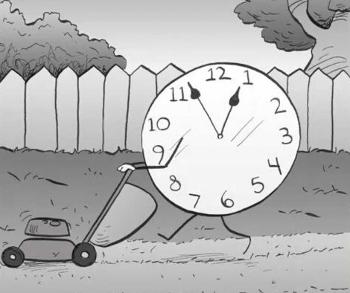
The most common cold-season grass varieties, like Kentucky Bluegrass and Tall Fescue, must be mowed by a professional lawn care company every week. Hold off the mowing till you have given the grass enough time to grow to a height of 4 to 5 inches. You should keep the grass at an altitude of 2.5 to 3.5 inches. This gives it significant drought and heat resistance. Also, this height leads to deeper rooting, which will help you to save water and fertilizer. A few more tips to remember when mowing cool-season grasses are:
• Mulch the grass clippings for natural and organic lawn fertilization.
• Sharpen mower blades regularly to prevent stressing the plants.
• Sharp blades also help against fungal growth.
• Don’t remove more than 1/3rd of the total blade length simultaneously.
• For longer blades, mow once on a high setting and a second time a few days later at a low setting to prevent going over the 1/3rd limit.
• Scalped or short-trimmed grass has a minor root system and is more susceptible to heat and drought damage. So, don’t go overboard with your mowing.
Here are a few tips for watering the lawn
• As long as the weather brings frequent rain showers and cold temperatures, you don’t have to water the lawn.
• Although spring droughts are rare in the northern part of the country if you have a dry spring this year, do water the yard once a week.
• Cold season grasses will go dormant during extreme drought and turn yellow, but they will regain their verdant look once the rain and cooler temperatures return.
• Early morning is the best time to water the lawn. So, schedule your watering between 4 a.m. to 8 a.m.
• The first visible sign of dehydration can be seen in the form of wilting or a bluish tinge on the blades.
• To test soil moisture, make a ball with the soil extracted from the first six inches of the ground. If you get a moist, but not drippy, soil ball, the moisture level is just right.
Simple Ways to Make Your Senior Living Space Feel Like Home

Moving into a senior living home can feel like a huge life change, but there are ways that you can make your living space feel more comfortable and just like home. You can turn any room into a house in many different ways. Luckily for you, they don’t even take a lot of extra effort and can be done in a matter of minutes. Making your senior living space feel like home is essential because you want to be comfortable and welcome into your new room.
Display Your Favorite Family Photos
One of the quickest and easiest ways to make your senior living space feel like home is to display your favourite family photos anywhere and everywhere. If you already have some printed out and framed, place them around your new space where ever you see fit. You may want to get with a family member to find an old photo album from which you can get pictures.
On the other hand, if you don’t have them on hand, it is easy to get some printed. Please talk with a family member so they can help you pick out your favourite family photos that have been taken over the years. Since most images are now taken digitally, your family members will have tons of pictures saved on their phones that they can take to Staples to get printed for a low price. You can buy inexpensive frames and hang photos around your new senior living home.
Another great spot for pictures is on the refrigerator! Get some awesome magnetics and hang your favourite photos all over your refrigerator or any magnetic surface in your new home.
Comfortable Sitting Area
Your sitting area is a room in your new senior living home that you will probably be utilizing a lot. This is a place where you can watch television, read a book, visit with friends or family, or even do another hobby, so you will want to ensure that this is a comfortable area. There are many ways to make your sitting area comfortable, and the first is by having an excellent place to sit. If you have furniture that you like from your old home, then that’s a great way to make this area feel more like home.
On the other hand, you could always purchase some new furniture that you find welcoming, comfortable, and homey. Ensure you have an end table or coffee table and shelves if needed. Depending on your interests, you may also want a television or radio in this room.
Another great way to make your sitting area more comfortable and feel like home is by having comfy blankets and pillows you and your guests can use. Throw pillows are a great way to add a decorative touch to your sitting room.
Decorate Your Bathroom
Another great way to turn your senior living space into a home is by decorating your bathroom with fun, bright colours. You will go to your toilet several times daily, so having it colourful and fun is friendly. You could choose colours like yellow, blue, pink, or green. The options are endless, and the choice is up to you when decorating your bathroom.
When picking things for your bathroom, you should also ensure that you have products that make you feel at home. Using certain products in the bathroom can turn your senior living space into somewhere you feel more comfortable.
Keep Your Favorite Items
Buying new items for a new place to live can be fun, but it might feel like something other than your home. When decorating your senior living space, you should mix some of your favourite items with new things. If you have a favourite rug still in excellent condition, consider bringing that with you to help decorate your new space. You also want to bring along your favourite quilt if it brings you good memories and makes you feel at home.
When moving to your senior living space, you should think about everything that makes your house a home and try to bring some with you to help decorate your new room. This way, you can get some of your memories to help you feel comfortable in your new home.
Have Enough Storage
Sometimes you may feel cramped when it comes to senior living spaces. An excellent way to make your area feel more significant and like you have more room is to create more organization and have enough storage space. You can purchase flat storage bins that can slide right under your bed. This is a great way to access some of your belongings but neatly put them out of sight when you don’t need them.
You should make sure that you have organized your closet space. Utilizing your closet and putting things in their rightful spots is a great way to make your senior living space feel like home.
Benefits of Hiring a Professional Landscaping Service
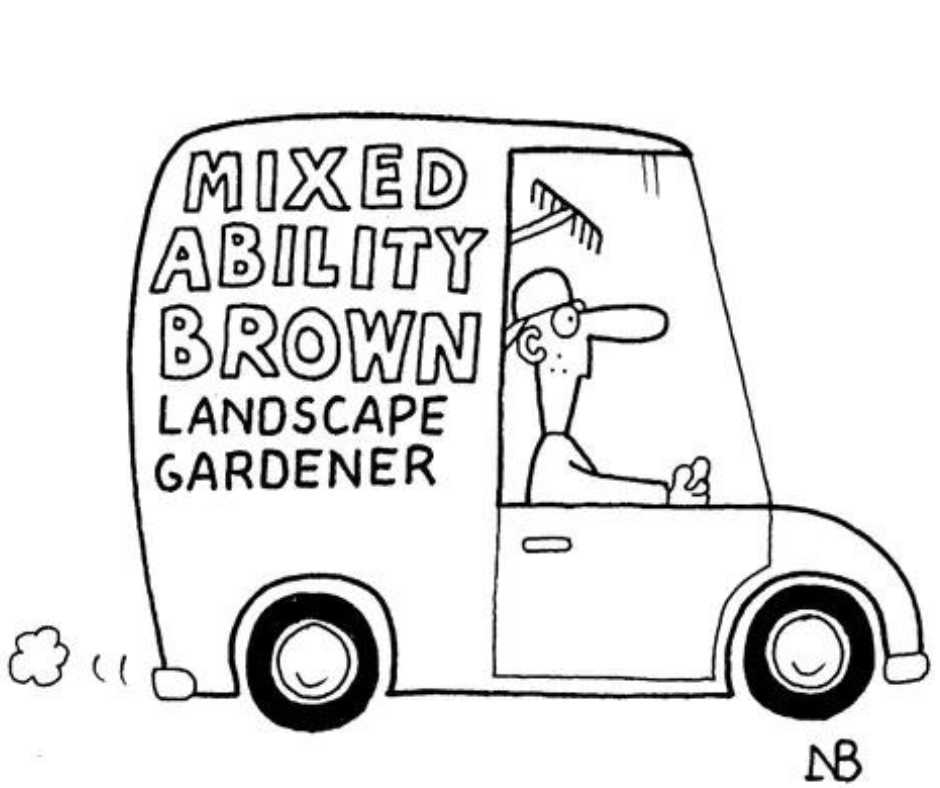
The reason this industry is enormous isn't that people need help planting their flowers. All the benefits of landscaping exceed their aesthetic value. It also includes more than gardening because landscape design can transform the structure of your outdoor space. You can use your next outdoor renovation project to change how you view and use your yard.
Here are some surprising reasons to invest in a landscaping project.
Gives You More Privacy
What's landscaping that also takes into consideration your neighbourhood and surroundings? Professional landscapers can use nature to block out loud noises and unsightly highways or neighbours. Plus, you can strategically use landscape design to add privacy to windows in the front of your home. Your backyard can be transformed into a secluded oasis no matter where you live.
Improves Property Function
Even if you already have a garden, landscaping help from Cyrus Landscaping can add functionality like a custom patio and walkways to let you enjoy your oasis. Landscapers can also choose plants and flowers to make it easy to maintain and get the most out of your yard. Plants like trees can provide the necessary shade, so you can walk in your garden without burning under the sun. You can also add good landscaping designs, like a sitting area in the shade.
Good for Your Health
By having a lovely landscape to enjoy, you spend more time outdoors. And it is proven that more time outside is better for your health, from lowering your blood pressure to enhancing your memory.
And even if you get help to create your landscape, maintaining it takes some physical effort. Gardening includes stretching, bending, and reaching, as well as strength and cardio training.
A Great Investment
As a homeowner, your home's curb appeal increases its overall value. It also gets your home noticed by potential buyers and your neighbours, who will want to rehab their lawn when they see yours. For businesses, aesthetic landscapes show that you are reputable and professional. This makes customers more comfortable spending money on your services.
Going, Green
What is a landscape other than a place to truly impact the environment? By planting more greenery, you increase the oxygen in the air and provide more CO2 vacuums. Environmental landscaping also creates more homes for wildlife and food for bees and insects. This improves the biodiversity of your neighbourhood and keeps the environment clean and functional. Removing old shrubs, clutter, and dead plant life lets you keep unwanted critters like roaches, rats, and mosquitoes out of your yard.
Here are a few tips for keeping weeds away from your lawn:
Don’t use core aeration after applying pre-emergent herbicides, as the coring will break through the anti-germination shield created by the herbicide. If you must re-seed in spring, use a pre-emergent herbicide that does not affect grass seeds.
Deal with perennial weeds like dandelion and crabgrass in spring. So, you don’t give them the time to grow stronger. Use post-emergent herbicide in the fall, particularly if you have a problem with broadleaf weeds like dandelion.
For weed control without using herbicides, keep an eye out for the shoots and pull them out consistently. If you cannot pull the weeds out by their roots, snap off the flowering stems to prevent seed propagation.
Want to keep Lawn Maintenance Low? It depends on the type of lawn and service you want. If you fertilize in spring, the growth will no doubt be luxuriant and deep green, but you will get it at the cost of root system development. This means your lawn will be more susceptible to diseases and pests. Plus, when fertilizing the lawn in spring, you inadvertently supply nutrients to weeds like crabgrass. I am sure you have already reckoned that this means your yard will need a lot of maintenance. In contrast, if you fertilize in the fall, you will bypass these issues and have a comparatively low-maintenance yard. That said, nitrogen should be the primary nutrient you supply when fertilizing cold-season yards because most cold-season grasses are gluttons for nitrogen.
Weed-free lawn tips:
Aeration will help to reduce weeds. Here are a few tips for keeping weeds away from your lawn. Opportunistic weeds germinate in areas where they can be successful. Crabgrass grows in thin areas, nutsedge pops up in thin/low spots, and broadleaf weeds spread where there is little desirable grass. The best defence is to have a thick lawn. Don't use core aeration after applying pre-emergent herbicides, as the coring will break through the herbicide's anti-germination shield.
Reseeding: When your lawn revives in the spring, it may not be as thick or green as you would like. A yearly reseeding might be necessary to keep it in tip-top shape. You don't just have to sit around and wait for the timing. Make sure you know a) what kind of seed you are planting and b) what soil you are planting them in.
What type of seed should you choose? We Suggest using Kentucky-certified creeping Red Fescue and Perennial Ryegrass. For overseeding, 0.75 lbs can cover 1,000 sq. ft. Going price is $12.99 at Blue Grass Nursery in Balzac; you can contact them at 403-226-0468
Deal with perennial weeds like dandelion and Crabgrass in spring so you don't give them the time to grow stronger. Using a dethatcher in spring helps minimize weeds. Dethatching also helps reduce thatch. A thick thatch layer can prevent water, air, and nutrients from reaching the soil and roots, making grass susceptible to disease and pests. Dethatching also allows you to aerate your lawn at the same time, which can improve drainage and help the roots grow deeper. Dethatching your lawn can be an essential step in taking an average-looking yard and making it something spectacular; however, if you don't know what you're doing, you can end up doing more damage than good today;
We are going to talk about seven common mistakes the average DIYER makes that can end up costing them time money and making things worse in the long run, if you're new to Lawn Care you've never dethatched before it's simply the process of removing dead organic material from the top of your soil that can inhibit air water and nutrients from getting down into the roots of your grass, removing that layer of dead organic material in the top of your soil allows your grass to breathe take in nutrients.
The first Common mistake the average diyer makes when dethatching their lawn is just choosing the wrong time of year to dethatch regardless of your grass type you want to make sure you dethatch your grass while it's actively growing for cool season grass like I have that's late spring or fall when the grass is really growing and thriving, if you have warm season grass early summertime or anytime throughout that summer growing season is ideal for you the process of dethatching can be stressful on your lawn so you want to make sure that you're not doing this during times of dormancy or when your grass is already stressed out by the elements that can open you up to disease problems or weed issues that can end up making your lawn worse in the long run.
The second common mistake the average diyer makes when dethatching their lawn is using the wrong equipment if you have a small yard and it's not going to take you long to rake that entire thing going through with the dethatching rake can pull that thatch layer out and you can get the job done relatively quickly, however if you have a larger space something up to about 10 000 square feet you're going to want to go with a powered option the one that I've been using which has given me great results is the billy goat dethatcher it's a power raker that uses fuel. DIYers can purchase a billy goat from Arnes Equipments 2024 CR551V - Billy Goat for $2999.99. You can call them for more info at 403-908-9811.
The following common mistake when dethatching is doing the process while your grass is wet. It's early morning, and the ground is still covered in dew. If you've just had rain or run your irrigation system, there are better times to go through with your dethatching machine. Everything is going to get gunked up in your machine. It will be harder for all that thatch to get pulled up to the top of the surface, so doing this. At the same time, your grass is dry and will be a better option if you have in-ground irrigation. Turn off your sprinklers for a few days, wait for the weather to have no rain, and wait for everything to dry out just a little bit. It will allow the dethatching rake, the electric dethatcher, or your powered scarifier to lift that thatch and pull it up to the surface. It will be a lot easier for you to collect that batch after you've gone through your lawn.
The fourth common mistake has to do with pre-emergent applications. Pre-emergent herbicides are put down either in a granular or liquid form, and what they do is they prevent weeds, specifically grassy weeds like Crabgrass, from popping up and causing problems in your lawn if you've put down a pre-emergent herbicide. You do not want to dethatch after you've done that because that dethatching process can interfere with the barrier in your soil that prevents those weeds from popping up, so if you've already put down your pre-emergent application, you may want to wait for a different time to dethatch your lawn.
The last mistake we want to avoid is fertilization after dethatching your lawn. As I mentioned already, the dethatching process will cause some stress to your grass. Still, putting down some fertilizer immediately after dethatching your lawn will give it all the nutrients it needs to bounce back and start thriving the way it should. If you neglect to do that, there's a good chance that weeds will have more of an opportunity to take over your lawn. It's just not going to bounce back as quickly as it should, so once you're done with dethatching, you want to make sure you remove all that dead material and put down a fertilizer, which will allow your grass to start thriving. Use eco-friendly fertilizer in the fall, particularly if you have a problem with broadleaf weeds like dandelion.
Want to keep Lawn Maintenance Low?
It depends on the type of lawn and service you want. If you fertilize in spring, the growth will no doubt be luxuriant and deep green, but you will get it at the cost of root system development. This means your lawn will be more susceptible to diseases and pests. Plus, when fertilizing the lawn in spring, you inadvertently supply nutrients to weeds like Crabgrass. I am sure you have already reckoned that this means your yard will need a lot of maintenance. In contrast, if you fertilize in the fall, you will bypass these issues and have a comparatively low-maintenance yard. Nitrogen should be the primary nutrient you supply when fertilizing cold-season yards because most grasses are gluttons for nitrogen.
With Cyrus Landscaping, customers can enjoy an extensive list of services that cover property maintenance requirements throughout the year. Call Cyrus at 403-200-4548
Weed free lawn tips
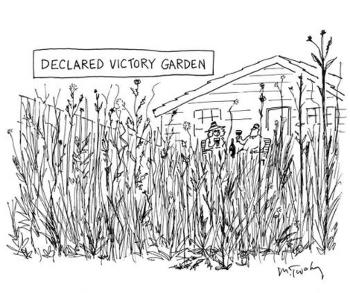
3 ways of teaching kids about garden

There are many outstanding achievements and benefits you might expect to come out of teaching kids about the garden. The garden is an essential part of the home, and the more involved you can get kids in it, the more you will find it is being looked after properly. But It’s also an essential thing for the children to appreciate, and you might discover that there are significant benefits to teaching kids about the garden and getting them more involved. If you are thinking about doing this but don’t know where to start, look at the following.
Sowing seeds
One of the great joys you can instil in your children is learning to grow plants from seed; a great place to start teaching kids about the garden.
Sowing seeds can be fun and educational in this way, and you should find it interests your children. When you teach your children the joy of sowing seeds, you will find that it amazes them, which will probably mean they will want to do it again. That is undoubtedly a valuable skill to have, and it is something that you can easily teach them in an afternoon. It’s good to start with something that grows visibly and fast, such as cress. You might even encourage the seeds with some moist paper towels or by covering them with clingfilm. All of this can be an excellent opportunity for education for your children, and you should make the most of that opportunity as you see fit.
Keeping animals
If you have the space and you are keen to keep some animals, then this is something else you should encourage your kids to help out with. Keeping animals does wonders for children: it enables them to gain confidence around animals which can help later in life should they come into contact with them in the wild.
It also means that they can appreciate and understand animal welfare issues. You should be able to easily keep some animals in your garden, such as chickens and ducks.
The benefit of keeping chickens and ducks is that you get a daily supply of eggs. You can collect these eggs with your children – which they will find magical – or ask them to help you feed them with Little Peckers Bird Food. Either way, it’s an excellent experience for them.
Weeding
A simple task that always needs doing, you will find that you always want a bit of help when weeding your garden. It is also a great thing to get your children used to doing, as it helps them to distinguish between plants – a helpful ability which improves their general understanding of nature. Show them how to pull weeds from the roots and ensure they don’t return.
We hope these are helpful ideas for teaching kids about the garden; do have a look at some of the other garden-related resources on the site:
Make a flower pot fairy garden,
Take a look at our bug hunt printable to get the kids spotting the wildlife,
Colour in these fabulous adult and kids butterfly colouring pages, and
Finally, here are five tips to help create imaginative play spaces in the garden.
If you are looking for other activities off-site – have a bash at these too:
Play dough activities in the garden from Mama, Papa and Bubba,
17 activities for the kids in the garden from Teaching Mama,
Fun-a-Day has some more fairy garden ideas, and
Last but not least, Fantastic Fun and Learning has some science ideas for you for the garden.
Benefits of dandelions for athletes
